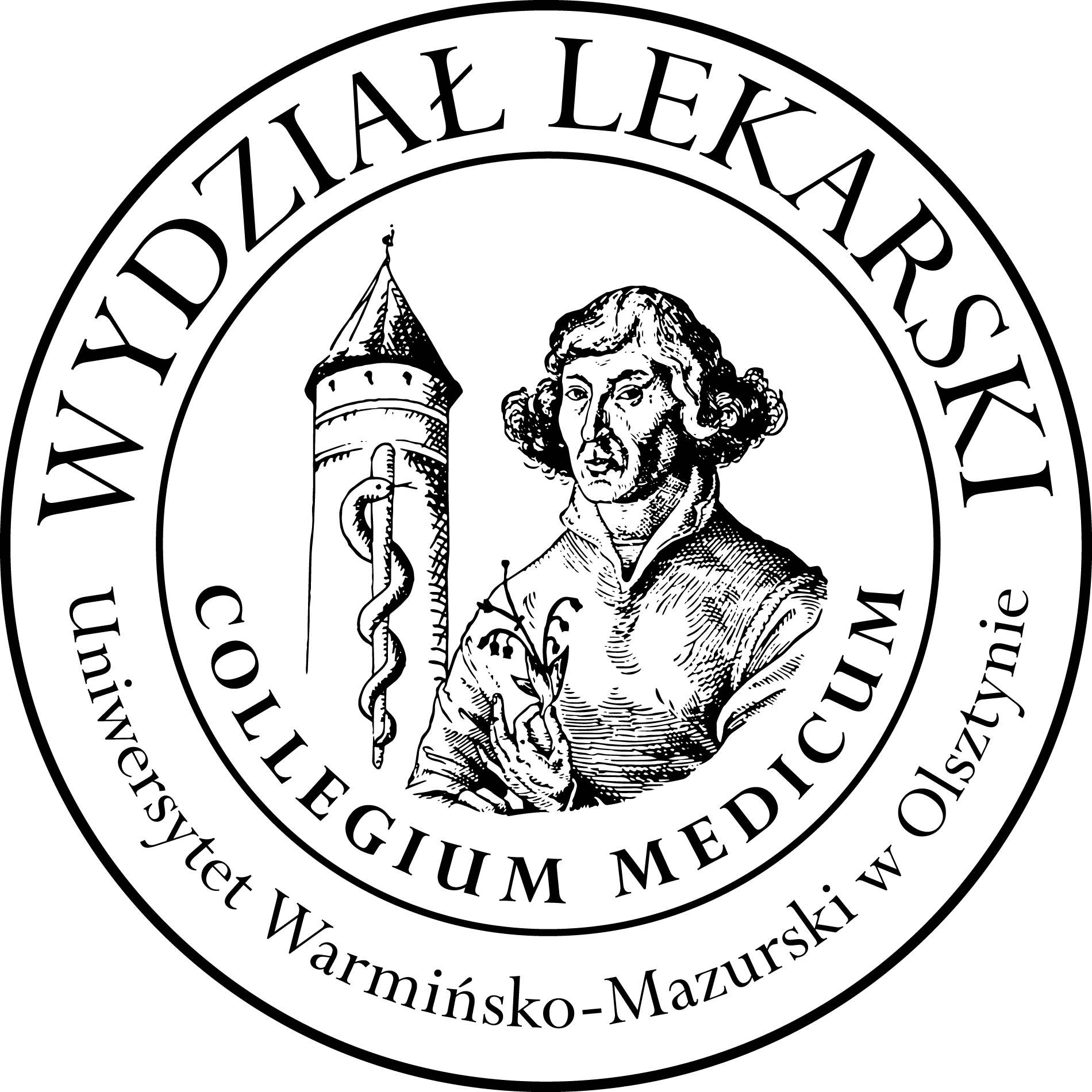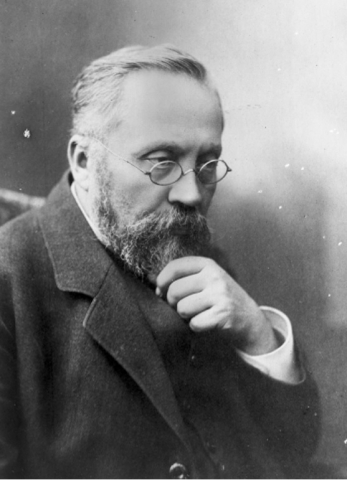Napoleon Cybulski
Napoleon Nikodem Cybulski was born on September 14, 1854 in the property Krzywonosy in Lithuania, which in the 19th century was in the Russian Empire (present-day Belarus) in a Polish-Lithuanian noble family. He was named after Napoleon Bonaparte, whom his father adored. After years, Cybulski mentioned that his childhood was carefree, but he often was punished for an excessive interest in frogs and reptiles (on which he performed physiological experiments in later life).
In 1875, Cybulski graduated with a silver medal from secondary school in Mińsk and started to study medicine at the Military Medical Academy in Saint Petersburg – the best medical school in the Russian Empire. He was a very capable and hardworking student. When Cybulski was on the second year of study (in 1877), he came to the attention of a professor of physiology - Iwan Tarchanow and started to work at the Department of Physiology. The result of this work was the first scientific article of Cybulski entitled “About the influence of the postures on blood pressure, heart rate and respiration in animals” published in 1878. In 1880 Cybulski published two other scientific works, for which he received a gold medal of the first class. During the study, Cybulski met another future famous physiologist - Ivan Pavlov.


Napoleon Cybulski got a medical degree in 1880 with the highest distinction. After the graduation he continued work in the Department of Physiology under prof. Tarchanow. In 1881 he became the prosector in this department. In 1885 Cybulski obtained the degree of doctor of medicine on the basis of a dissertation entitled “Studies on the blood flow rate using photohemotachometer” It should be pointed out that Cybulski was the instigator and constructor of the photohemotachometer. At that time Cybulski also studied the influence of the phrenic nerve on the respiration rate and on physiological processes within the vagal nerves.



In the same year (1885), the Faculty Council of the Faculty of Medicine of Jagiellonian University in Cracow (which at that time was in the Austro-Hungarian Empire) offered him the management of the Department of Physiology. So, Cybulski moved to Cracow and on October 1885 he became the head of the Department of Physiology at the Jagiellonian University. In Cracow, Cybulski developed his scientific activity. He is considered a founder of the Cracow School of Physiology. His students included a lot of later prominent Polish scientists, including Adolf Beck, Władysław Szymonowicz, Leon Wachholz, Aleksander Rosner and many others. The first years of Cybulski in Cracow has been described in the memoirs of Adolf Becka as follows:
“Cybulski got to difficult work of the teacher with extraordinary vigor, started to work on education of the number generations of surgeons, surrounded himself with numerous co-workers who started to do science. Cybulski spent his whole life to the science and to find the truth in biology. His accomplishments enriched not only physiology but also microscopic anatomy, pathology and other branches of medicine.”

At that time Cybulski made his greatest discoveries, such as the discovery of adrenaline or studies on electroencephalographic waves. The commitment of Cybulski in scientific and organizational work has been well recognized. In 1887–88 and 1895–96 he served as dean of the Faculty of Medicine and subsequently as rector (1904–5) and deputy rector (1905–9) of the university. Cybulski was also a member of numerous scientific associations. Among others from October 31,1891, he was an active member of the Academy of Learning. The scientific discoveries of Cybulski were also known all over the world, as evidenced by the fact that he was nominated for the Noble prize in 1911, 1914 and 1918. Cybulski was also a great academic teacher. He not only gave interesting lectures, but he is also the author of the first Polish manual of physiology – “Human physiology” (published in the years 1891-1896) in 4 volumes. Adolf Beck described the lectures of Cybulski in the following words: „”His lectures included numerous experiments and demonstrations They were clear, concise, riveting and logical and they drew attention of the students”.

Moreover, Napoleon Cybulski was also interested in social and ethical issues. He published some books and articles about these questions, including “Do the State and Society Have an Obligation to Support Science?” from 1895, “On the Organization of Peasant Farms” from 1896 and “Science and War” from 1918. Cybulski also studied the diet of the rural population (especially children) near Cracow. For many years Cybulski was a member of the Cracow City Council and in 1891 he established (together with the famous bacteriologist Odo Bujwid) the first gymnasium for girls in Cracow. Cybulski was also a strong supporter of medical education for women at the Jagiellonian University.

In spite of great achievements in the field of physiology and neuroscience, Napoleon Cybulski for many years ran the dental surgery office in Cracow in order to satisfy the financial needs of his wife Julia Rogozińska and their children.
Napoleon Cybulski died suddenly on April 26, 1919 of a stroke during scientific work in the Department of Physiology at the Jagiellonian University. He was posthumously awarded the Commander's Cross of the Order of Polonia Restituta. Adolf Beck said at the funeral of Cybulski: „He was the great scientist and researcher, master and guide, pride of the Jagiellonian University, an excellent professor, who did his duty to the last breath.”

Scientific achievements of Napoelon Nikodem Cybulski
Napoleon Cybulski published about 100 scientific papers.
The most important achievement of Napoleon Cybulski was the discovery of adrenaline. Experiments on this issue Cybulski conducted together with his pupil and assistant Władysław Szymonowicz. The first experiments on dogs with adrenal extirpation were made in May 1894. Then, in December 1894 Szymonowicz studied the influence of the adrenal gland extract on animals under physiological conditions and after adrenalectomy. Cybulski and Szymonowicz used dogs, rabbits, and cats injected with solutions of adrenal extracts in water, glycerin or alcohol. The results obtained during these experiments showed that animals after adrenalectomy died in a day. In turn the subcutaneous injection of a 10% water solution of adrenal extract caused immediate improvement in the respiration, blood pressure and heart rate, and the extract form adrenal medulla had a much stronger effect than that from the cortex. Cybulski also noted that after damage to the spinal cord, the impact of adrenal extract was not visible, which suggested that the influence on the heart blood pressure and respiration must be affected by the nervous system, not by the direct effect of it on peripheral vessels. Cybulski noted as follows: “Blood of the suprarenal vein contained the active principle of the gland in sufficient amount to mimic effect of adrenal extract.” He called this active substance “nadnerczyna” (which in Polish literally means "adrenalin": nadnercze is the Polish for "adrenal gland"). Moreover, some experiments showed that “nadnerczyna” is released under stressful conditions. For the first time, the results of these experiments were presented during a session of the Cracow Society of Physicians on March 6, 1895, where Cybulski gave a lecture about his discovery. During the lecture he said: “this substance (nadnerczyna), without which the function of the nervous system is impossible changes the way we understand interaction between different organs”.



Napoleon Cybulski was also the pioneer of electroencephalography. He noted changes in electric potentials between two electrodes located on different parts of the brain cortex. On the basis of this observation in 1890 Cybulski and his assistant and friend Adolf Beck made one of the first-ever EEG examinations of the cerebral cortex. They observed cerebral cortex activity of various animal species (especially in dogs and monkeys) under physiological conditions and after stimulation of peripheral nerves. The results obtained during these observations showed that bioelectrical signals from the cerebral cortex depended on the kind and severity of stimulation and depth of anesthesia. On the basis of EEG examinations, Cybulski ad Beck determined the localization of sensory regions located in the cerebral cortex. The observations of Cybulski and Beck became a cornerstone of electroencephalography – one of the most important noninvasive methods of examination activity of the brain. In later years (1914) Cybulski studied brain activity during epileptic seizures.

Moreover, Cybulski studied (together with Józef Zanietowski) the excitability of neuronal and muscular cells. To study muscular excitability, Cybulski and Zanietowski for the first time used the chronaxy method. Cybulski also introduced the concept of “resting current” as a property of the neuronal or muscular membrane and “action current” – connected with the movement of ions along the cellular membrane within the nervous or muscular system.

Other scientific achievements of Napoleon Cybulski include:
- studies on receptors taking part in taste stimuli conduction and observation that the sensation of every kind of taste is caused by a separate kind of receptor
- observation concerning afferent and efferent impulses entering and leaving the spinal cord
- studies on blood flow velocity. Cybulski was the first to show a graphic diagram of the correlations between blood flow velocity and phases of heart cycles with the use of his own constructed photohemotachometer. He also studied changes in blood flow velocity during various pathological states (for example in pregnant women with jaundice). Interestingly studies with a photohemotachometer were conducted even in the second half of the 20th century.
- the invention of a microcalorimeter – the apparatus for measuring the amount of heat generated by muscles
- studies on the correlations between the increase in intracranial pressure and disturbances in the brain blood flow.
- works on the physiology of the heart. In 1910, Napoleon Cybulski, as the first Polish researcher, obtained a record of electric heart action.
- research on hypnosis. Cybulski is an author of a work entitled “On hypnosis from the physiological standpoint” published in 1887 and a thesis contained in this work anticipates the ideas of Sigmund Freud.





